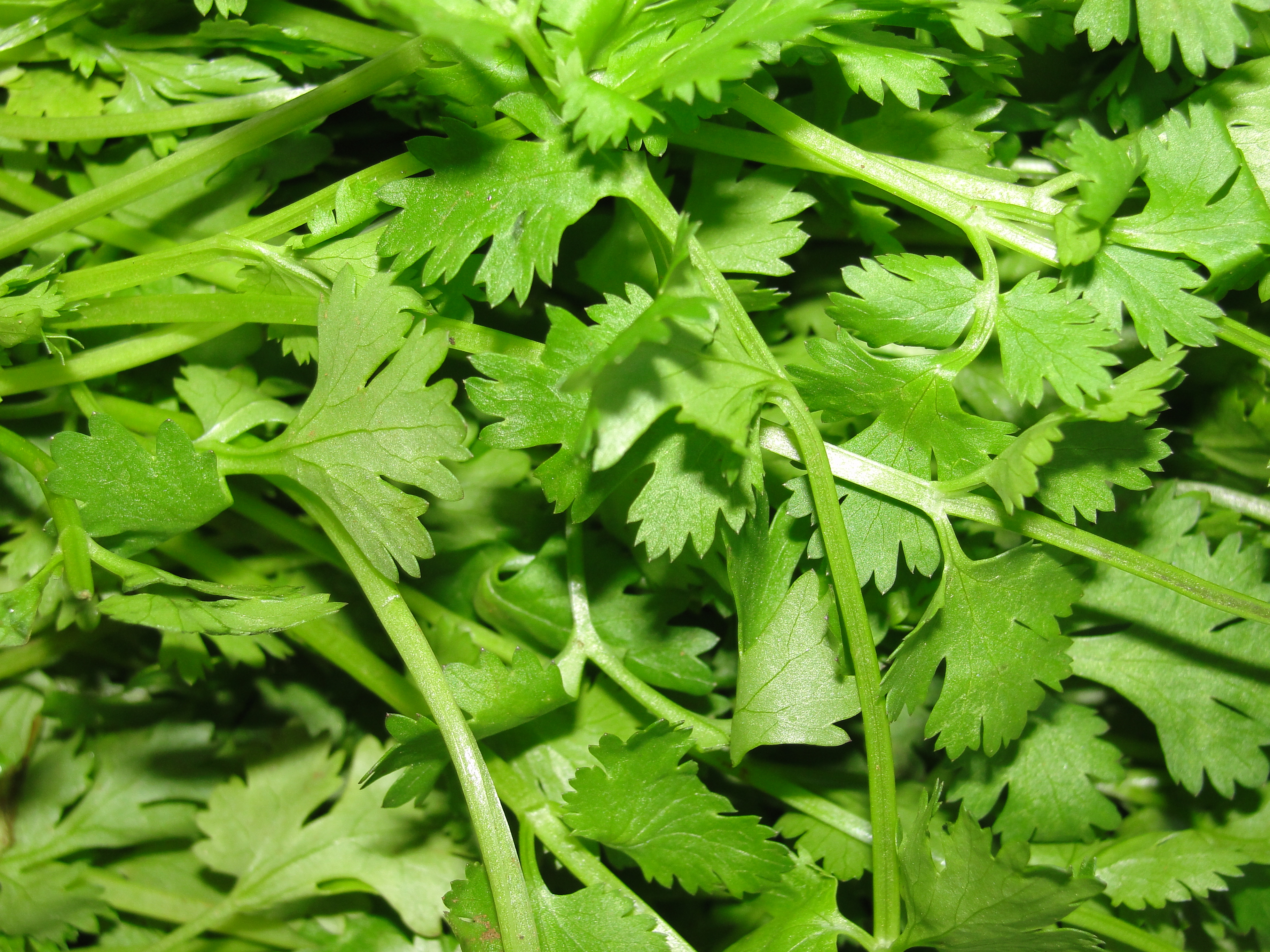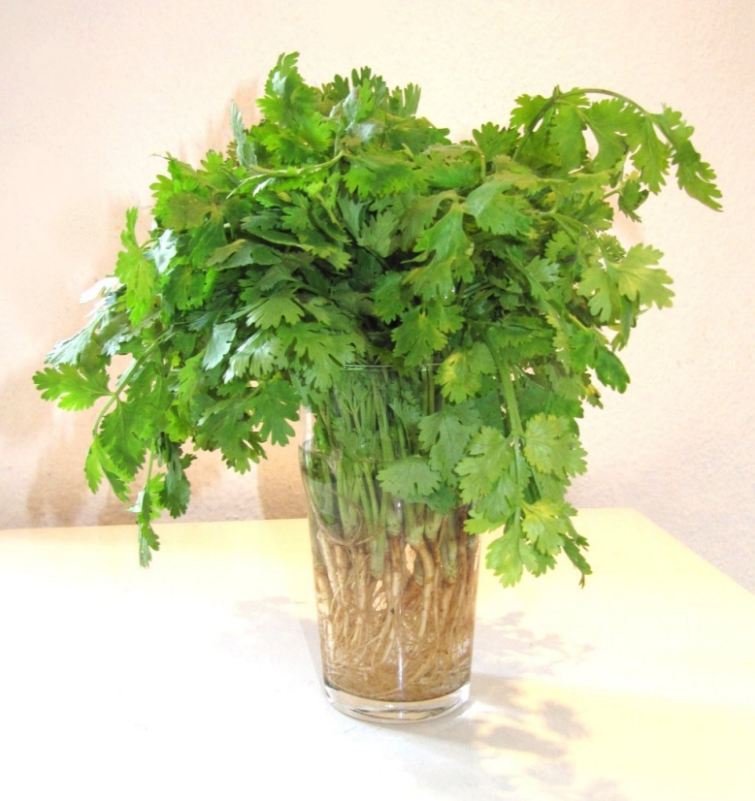A Brief Introduction:
Coriander (Coriandrum sativum), also known as cilantro, Chinese parsley or dhania, is an annual herb in the family Apiaceae. Coriander is native to regions spanning from southern Europe and North Africa to southwestern Asia. It is a soft, hairless plant growing to 50 cm (20 in) tall. The leaves are variable in shape, broadly lobed at the base of the plant, and slender and feathery higher on the flowering stems. The flowers are borne in small umbels, white or very pale pink, asymmetrical, with the petals pointing away from the centre of the umbel longer (5–6 mm) than those pointing towards it (only 1–3 mm long). The fruit is a globular, dry schizocarp 3–5 mm (0.12–0.20 in) in diameter.
History: Coriander grows wild over a wide area of the Near East and southern Europe, prompting the comment, "It is hard to define exactly where this plant is wild and where it only recently established itself."Fifteen desiccated mericarps were found in the Pre-Pottery Neolithic Blevel of the Nahal Hemel Cave in Israel, which may be the oldest archaeological find of coriander. About half a litre of coriander mericarps were recovered from the tomb ofTutankhamen, and because this plant does not grow wild in Egypt, Zohary and Hopf interpret this find as proof that coriander was cultivated by the ancient Egyptians. The Bible mentions coriander in Exodus 16:31: "And the house of Israel began to call its name manna: and it was round like coriander seed, and its taste was like that of flat cakes made with honey."

References:
Coriander (Coriandrum sativum), also known as cilantro, Chinese parsley or dhania, is an annual herb in the family Apiaceae. Coriander is native to regions spanning from southern Europe and North Africa to southwestern Asia. It is a soft, hairless plant growing to 50 cm (20 in) tall. The leaves are variable in shape, broadly lobed at the base of the plant, and slender and feathery higher on the flowering stems. The flowers are borne in small umbels, white or very pale pink, asymmetrical, with the petals pointing away from the centre of the umbel longer (5–6 mm) than those pointing towards it (only 1–3 mm long). The fruit is a globular, dry schizocarp 3–5 mm (0.12–0.20 in) in diameter.
History: Coriander grows wild over a wide area of the Near East and southern Europe, prompting the comment, "It is hard to define exactly where this plant is wild and where it only recently established itself."Fifteen desiccated mericarps were found in the Pre-Pottery Neolithic Blevel of the Nahal Hemel Cave in Israel, which may be the oldest archaeological find of coriander. About half a litre of coriander mericarps were recovered from the tomb ofTutankhamen, and because this plant does not grow wild in Egypt, Zohary and Hopf interpret this find as proof that coriander was cultivated by the ancient Egyptians. The Bible mentions coriander in Exodus 16:31: "And the house of Israel began to call its name manna: and it was round like coriander seed, and its taste was like that of flat cakes made with honey."
Coriander seems to have been cultivated in Greece since at least the second millennium BC. One of the Linear B tablets recovered from Pylos refers to the species as being cultivated for the manufacture of perfumes, and it appears that it was used in two forms: as a spice for its seeds and as a herb for the flavour of its leaves.This appears to be confirmed by archaeological evidence from the same period: the large quantities of the species retrieved from an Early Bronze Age layer at Sitagroi in Macedonia could point to cultivation of the species at that time.
Coriander was brought to the British colonies in North America in 1670, and was one of the first spices cultivated by early settlers
Parts Used---Fruit and fresh leaves.
Habitat---Coriander, an umbelliferous plant indigenous to southern Europe, is found occasionally in Britain in fields and waste places, and by the sides of rivers. It is frequently found in a semi-wild state in the east of England, having escaped from cultivation.
Description---It is an annual, with erect stems, 1 to 3 feet high, slender and branched. The lowest leaves are stalked and pinnate, the leaflets roundish or oval, slightly lobed. The segments of the uppermost leaves are linear and more divided. The flowers are in shortly-stalked umbels, five to ten rays, pale mauve, almost white, delicately pretty. The seed clusters are very symmetrical and the seeds fall as soon as ripe. The plant is bright green, shining, glabrous and intensely foetid.
Cultivation: Sow in mild, dry weather in April, in shallow drills, about 1/2 inch deep and 8 or 9 inches apart, and cover it evenly with the soil. The seeds are slow in germinating. The seeds may also be sown in March, in heat, for planting out in May.As the seeds ripen, about August, the disagreeable odour gives place to a pleasant aroma, and the plant is then cut down with sickles and when dry the fruit is threshed out. Constituents-Coriander fruit contains about 1 per cent of volatile oil, which is the active ingredient. It is pale yellow or colourless, and has the odour of Coriander and a mild aromatic taste. The fruit yields about 5 per cent of ash and contains also malic acid, tannin and some fatty matter.
Coriander fruit of the British Pharmacopoeia is directed to be obtained from plants cultivated in Britain, the fruit before being submitted to distillation being brushed or bruised.
The English-grown are said to have the finest flavour, though the Russian and German are the richest in oil. The Mogadore are the largest and brightest, but contain less oil, and the Bombay fruit, which are also large, are distinguished by their oval shape and yield the least oil of any.
Medicinal Action and Uses---Stimulant, aromatic and carminative. The powdered fruit, fluid extract and oil are chiefly used medicinally as flavouring to disguise the taste of active purgatives and correct their griping tendencies. It is an ingredient of the following compound preparations of the Pharmacopceia: confection, syrup and tincture of senna, and tincture and syrup of Rhubarb, and enters also into compounds with angelica gentian, jalap, quassia and lavender. As a corrigent to senna, it is considered superior to other aromatics.
If used too freely the seeds become narcotic.
Coriander water was formerly much esteemed as a carminative for windy colic.
- http://botanical.com/botanical/mgmh/c/corian99.html
- Oxford Advanced Learner's Dictionary.
- Daniel Zohary and Maria Hopf, Domestication of plants in the Old World, third edition (Oxford: Oxford University Press, 2000), pp. 205–206
- Fragiska, M. (2005). "Wild and Cultivated Vegetables, Herbs and Spices in Greek Antiquity". Environmental Archaeology 10 (1): 73–82.
- Chadwick, John (1976). The Mycenaean World. Cambridge University Press. p. 119.








Post a Comment